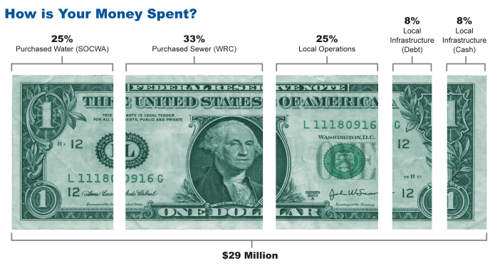Bloomfield Township purchases water from the Southeast Oakland County Water Authority (SOCWA) and is a community member of Oakland County's Evergreen-Farmington Sewage Disposal System for sewage services.
Following are new rates, as approved by the Township Board of Trustees, in effect as of April 1, 2025.
Variable/Usage Rates
Variable rates are based on the customer’s meter readings and charged per unit, or for every 1,000 gallons of water used.
WATER $6.90/unit
SEWER $12.40/unit
Service Fixed Fees
The Township’s system is designed around meeting the demands of customers 24 hours a day, 7 days a week, 365 days a year. The cost of maintaining that system in good working order to deliver safe and reliable service does not vary based on the amount of water customers use. Instead, the cost is related to making the service available to customers, whether they use any water or not. Rather than treating all customer the same (such as when charging the same RTS fee to all customers), the fee is based on the potential demand of each customer, determined by their meter size. This helps to improve equity in the rate structure by accounting for the fact that customers with larger meters represent greater potential demand on the system.
| Meter Size | Water Fixed Fee | Sewer Fixed Fee |
| 5/8" | $31.84 | $41.72 |
| 3/4" | $31.84 | $41.72 |
| 1" | $49.55 | $61.78 |
| 1 1/2" | $49.55 | $61.78 |
| 2" | $146.84 | $172.12 |
| 3" | $288.37 | $332.62 |
| 4" | $447.60 | $513.16 |
| 6" | $889.88 | $1,014.70 |
Should you have any questions about these rates, please contact the Department of Public Works at 248-594-2800.
Customer History
The Township’s water and sewer system began with the construction of the County’s sewer system in 1958 and water was extended later by DWSD in 1964. The Township originally had 3,300 water customers in 1965. By 1995, there were over 14,000 customers and as of today, over 15,600 customers. In the early years, the system expanded rapidly with new developments and was supported largely by connection fees for new customers being added to the system. Development and system expansion have greatly decreased in the past twenty years and the system now largely is being funded by the customer charges. These charges have historically relied heavily on the customers with high water usages to generate the revenue needed for the system. In addition to a decline in development, water volumes have also shown historic declines. Water volumes are dependent on customer usage and seasonal precipitation. Over the past 10 years Bloomfield Township's consumption has steadily declined by nearly 25%. This decline mirrors the water use trends of all the customers on the GLWA regional system.
How is Your Money Spent?
Water & Sewer Purchased - Commodity Charges
The commodity charges are the largest component, making up approximately 58% of the Township's water and sewer expense. These are the pass-through costs from SOCWA for water and from the OCWRC for the sewage treatment. Both agencies are wholesale customers of GLWA and their costs consist largely on what GLWA charges them.
Operating Expenses
The Township DPW – Water Division is responsible for operating and maintaining the water and sewer system which includes a one-million-gallon storage reservoir, ten pumping facilities, over 500 miles of pipes along with the attached manholes, hydrants and valves. In addition, over 15,000 water meters are read, billed and serviced. Township operating expenses make up only 25% of the overall water and sewer fund expenses.
Capital Projects - Debt/Cash
The average age of the water and sewer pipes within the Township’s system is 50 years old with some pipes nearly 90 years old. Much of the system is nearing or is beyond half of their useful service life. The capital component of the rate is comprised of debt for previously bonded infrastructure improvements and repairs as well as future cash funding to be used for major repairs and replacements needed for both the water and sewer systems. Cash funding allows for capital improvements to be done without selling bonds and increasing the bond debt.

